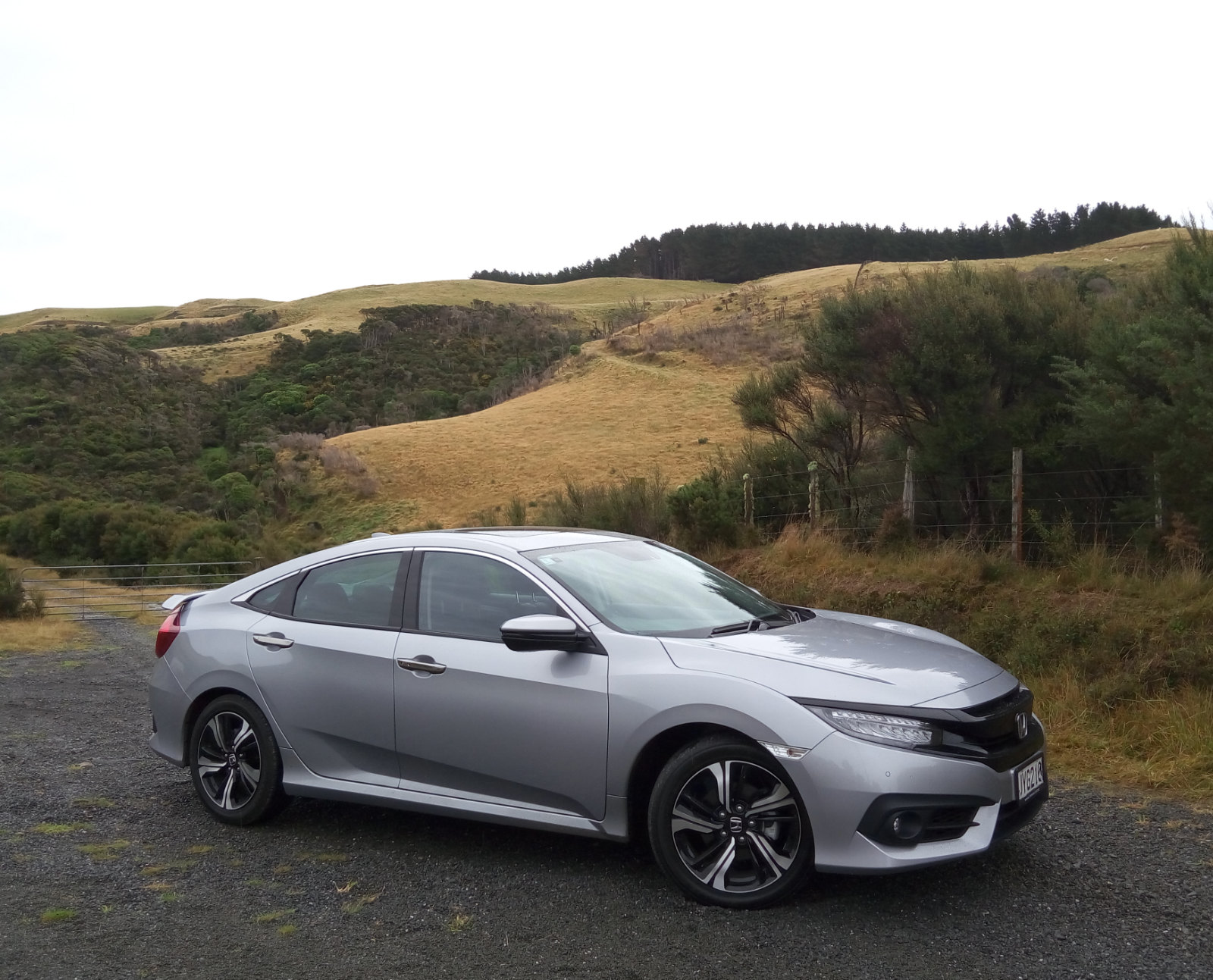
LIVING A ricer it ain’t: Jack Yan says the Honda Civic RS Turbo is a sophisticated and smart sedan with a competent chassis, so don’t let the badge fool you into thinking chavs will eye it up
Photographed by the author
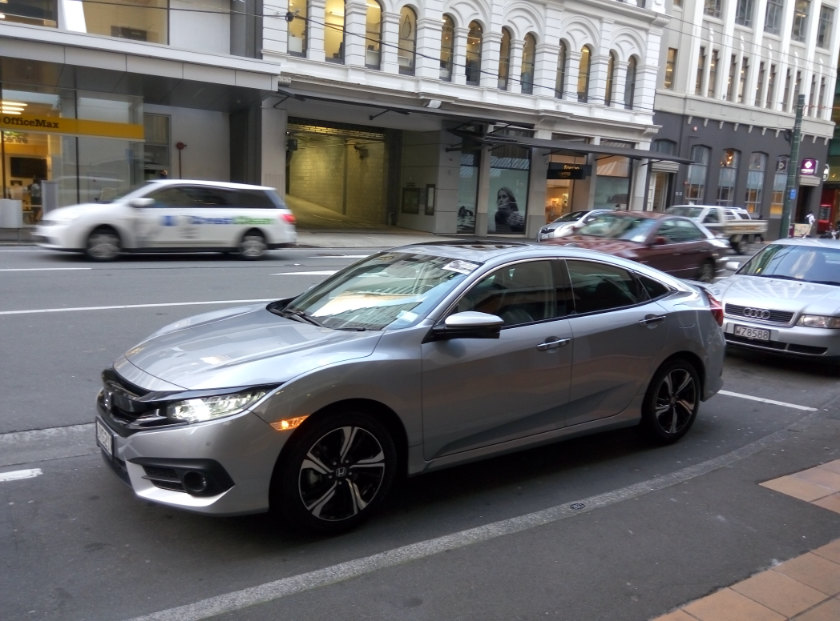
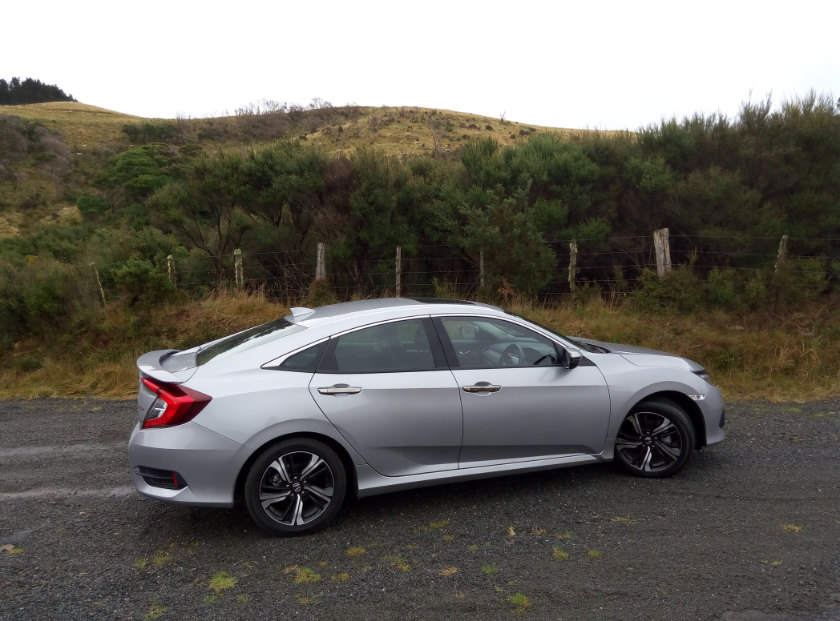
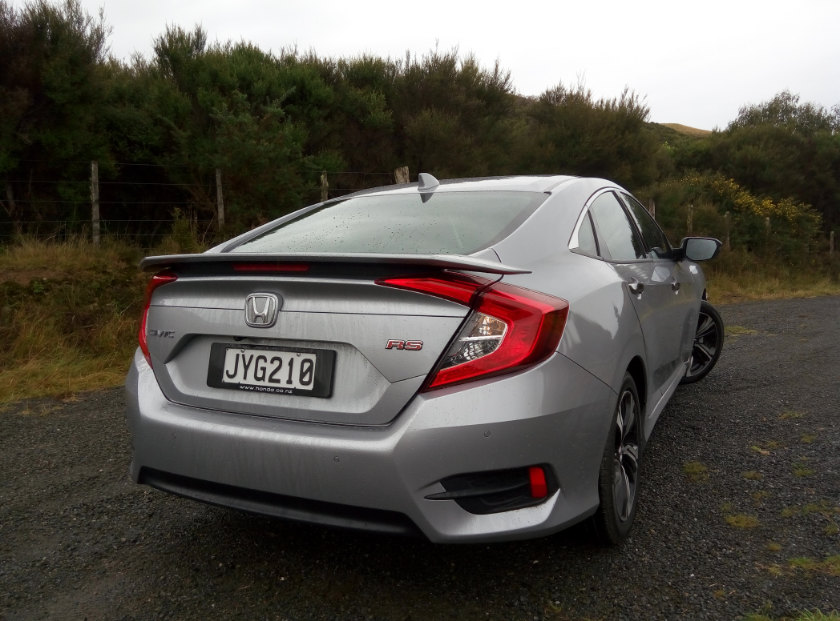
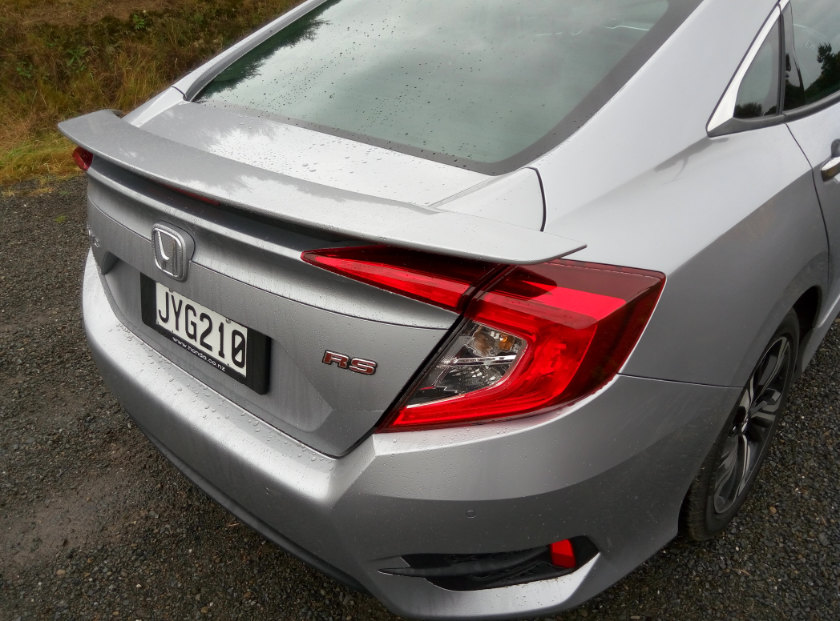
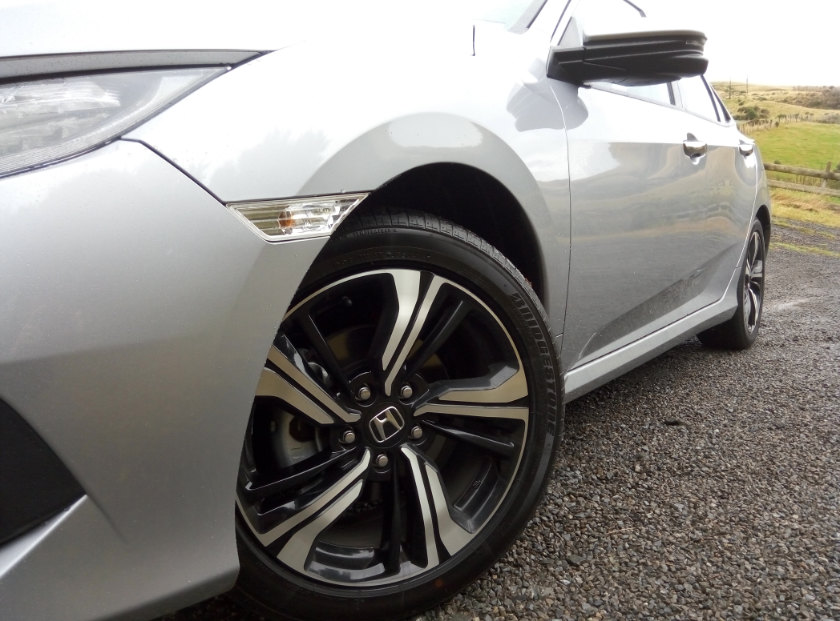
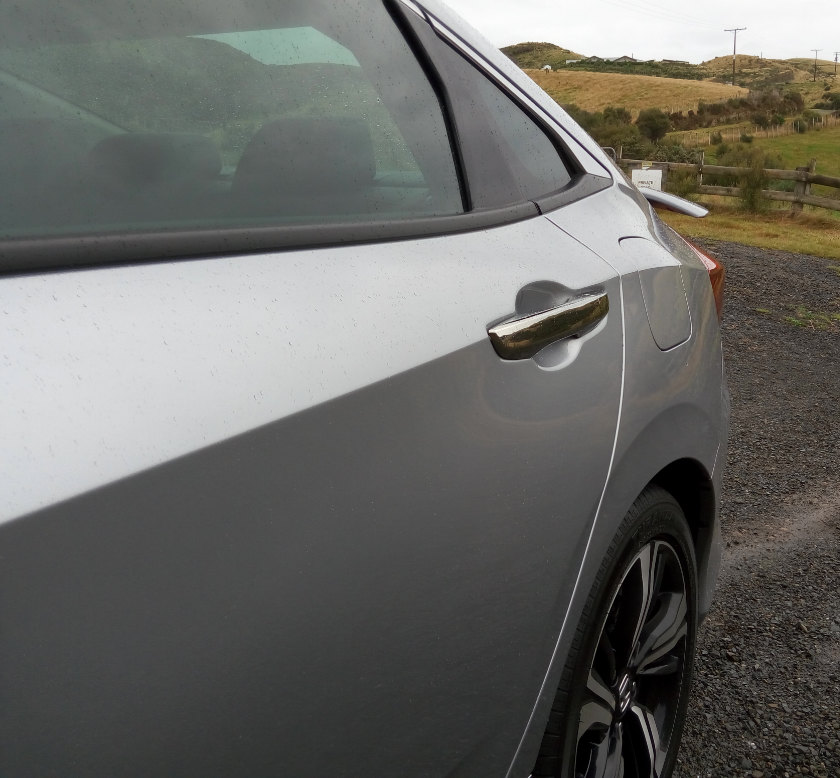 Proud Honda’s unashamedly Japanese styling is confident, making the Civic one of the best lookers in the segment
Proud Honda’s unashamedly Japanese styling is confident, making the Civic one of the best lookers in the segment
Jack Yan is publisher of Lucire.
The first car I ever sat behind the wheel of, at age three, was our neighbour’s new, four-door Honda Civic. Hong Kong, then a British colony, was largely served by British cars, but these newfangled imports from Japan were beginning to catch on. By this point in my life—we’re talking the mid-1970s—the taxi fleet was around 90 per cent Japanese (Nissan had cornered the market as Mercedes-Benz retreated), but Honda was a new player in the family-car market. What I remember clearly was the excitement as I pretended I was driving for real. But other than one night driving a friend’s 1985 Civic hatch (she had had a bit to drink), it took four decades for me to be behind the wheel of another Civic.
And what a Civic. I had been concerned about some of Honda’s 2000s’ models, such as the ill-defined US-market Crossback, the Pilot SUV (also for the US market), and the growth of the regular Accord into a dull big car beloved by retired executives, but the last few years have seen the company really regain its mojo. The Fit (Jazz for many export markets) has been the one B-segment car I have consistently recommended to friends hunting for a small Japanese hatchback for the last decade or more, and the current one’s a hoot to drive; the Clarity is a brave step into hydrogen fuel cell-powered cars and looks like a car of the future; and the recently revealed CR-V inherits the sportiness that Honda does so well. Honda, after all, should be brave: it’s part of their DNA. Through the 1980s, it mastered sporty Japanese styling, as well as conquered Formula 1 with its engines. Not bad for a company that started making engines that postwar Japanese could attach to their bicycles—and which now makes jet aircraft.
Honda is the one mass-market Japanese company that has a different philosophy: put simply, its founder wanted to make cars, while its rivals wanted to make money. That shows in the decisions Honda makes as a business, adventurous with new technologies such as rear multi-link suspension and variable valve timing, rather than relying on ideas that had gone before. Since they’re Japanese, the tech actually works and proves reliable in the long run.
The tenth-generation Civic has that rear multi-link suspension and variable valve timing; in lay terms it means the back grips better and the engine breathes better. But finally it has the looks to match the specs on paper. Honda’s materials provided to Lucire talk of a turbocharged 1·5-litre engine developing 127 kW (173 PS), and here’s a purposeful looking four-door fastback sedan that, at some angles, looks like a take-no-prisoners anime robot. The sculpting on the body remind me of origami folds, and the RS Turbo—the model we had on test—has blacked-out elements on the grille and alloy wheels, contributing to the notion that, given the right circumstances, we were really driving a Transformer.
Looks-wise, the Civic is bang up to date: there has been a casting off of bulbous, rounded shapes in favour of defined angles and creases; what Honda has done is tap into its origins to deliver something that’s proudly Japanese. This is a shape that, while acceptable worldwide (it’s won awards throughout the US and Canada in 2016) makes no apology for its national origins, something that couldn’t necessarily be said for the 2000–5 Civic hatchback, which tried hard to look European. We said of the Mazda 3, or Axela, a few months ago that it was ‘Japanese international’; but we think the Honda Civic has it pipped in the style stakes. Unlike Mazda, which brings influences together and interprets them in a Japanese way, Honda’s not tapping into anything outside Japan. Instead, it has made Japan incredibly palatable to international markets. Kind of like what chefs have done with their food. Except this looks even better.
Inside, the effect continues. Honda said the Civic had been benchmarked against the likes of the Audi A3, and it shows. This is a well screwed together interior that oozes quality, but, more importantly, that sporting theme continues with more black detailing, drilled pedals, and leather gear shifter. The seat belt clip rests flat against the belt itself: a small touch, but it works. The binnacle has three angular recesses for the instruments, and the middle one—it’s a fully digital, high-res display that displays a rev counter and a digital speedometer by default—can be customized to show fuel-economy information, compass direction, and the musical track you’re playing. The seven-inch screen in the centre console is even more informative, with both Android Auto and Apple Iphone Connect; though we think the pièce de résistance is the use of drawn lines to show how far away objects are behind you, aiding parking and overtaking. It’s helped by a camera housed in the passenger-side mirror, a small detail that proves to be very practical. Turn the left indicator on, and that camera starts displaying in the centre console, dealing with blind spots and showing any cyclists who may be coming up on your left.
Honda even lets you change the skin on the infotainment screen, so you don’t have to put up with the default, which does look garish to some eyes. However, we experienced a small glitch here: when we changed skins, the time seemed to have reset itself back to Japanese standard time. And it was one of a few little electronic bugs that Honda might want to note down for future updates.
continued below
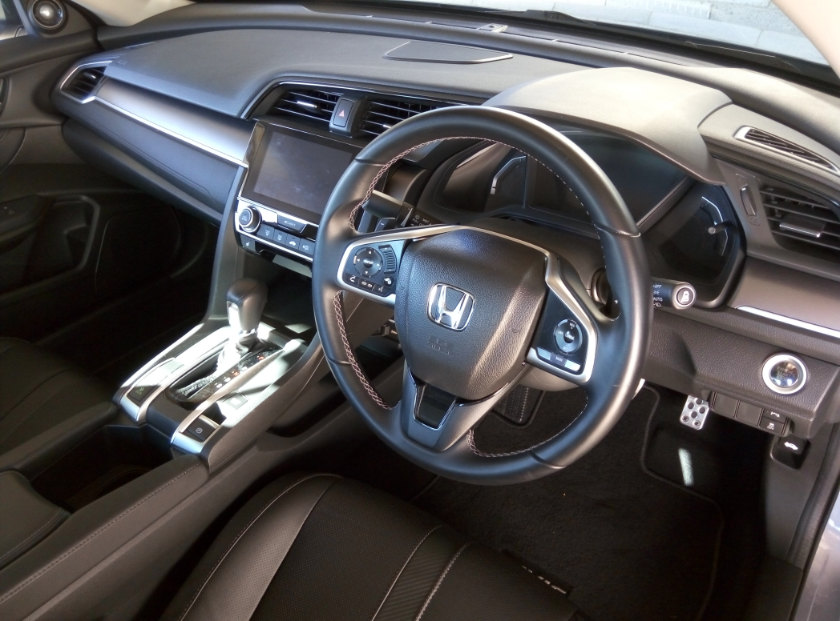
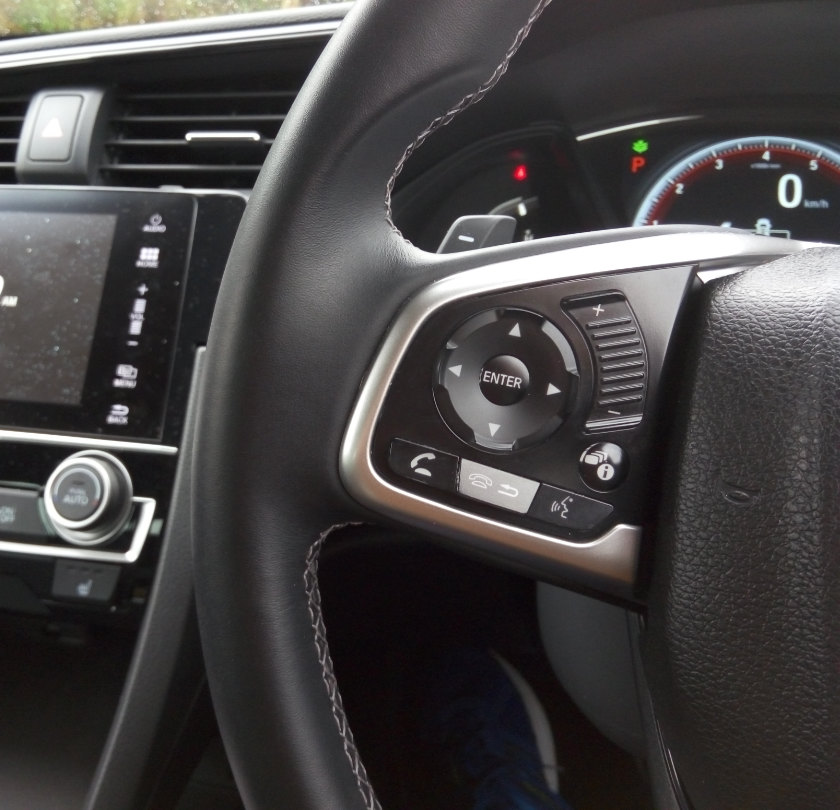
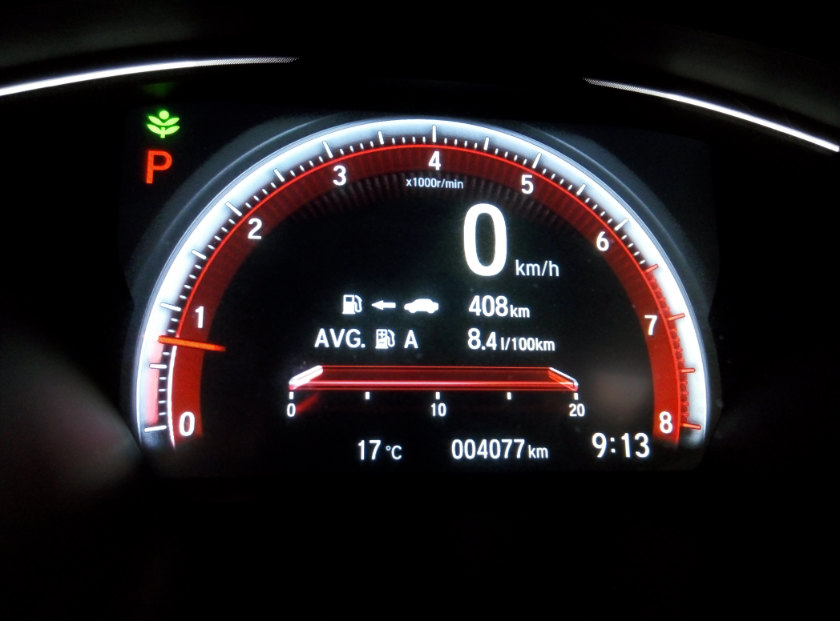
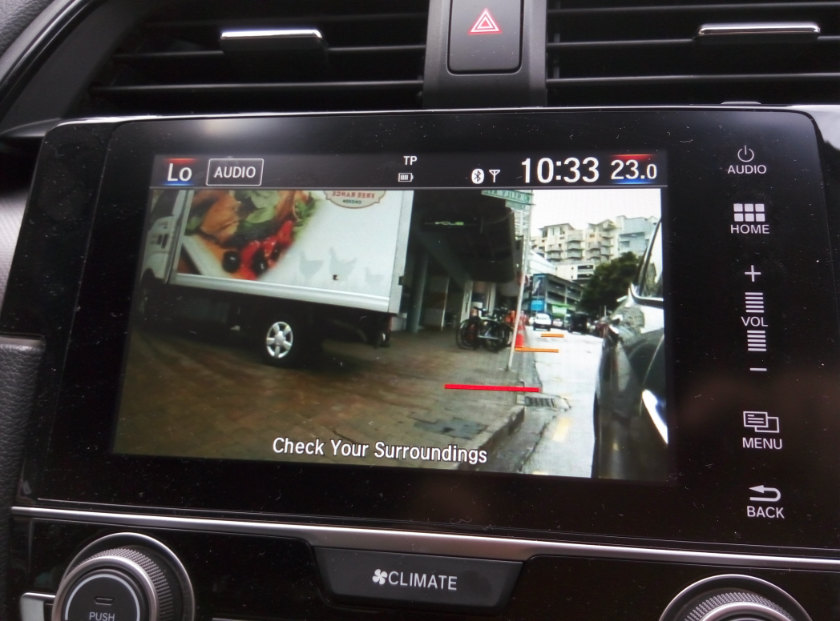
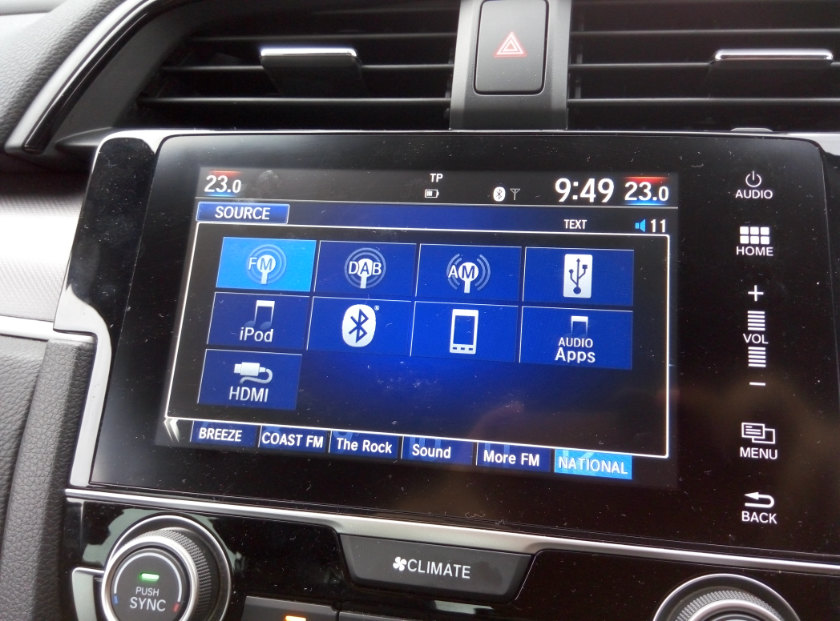
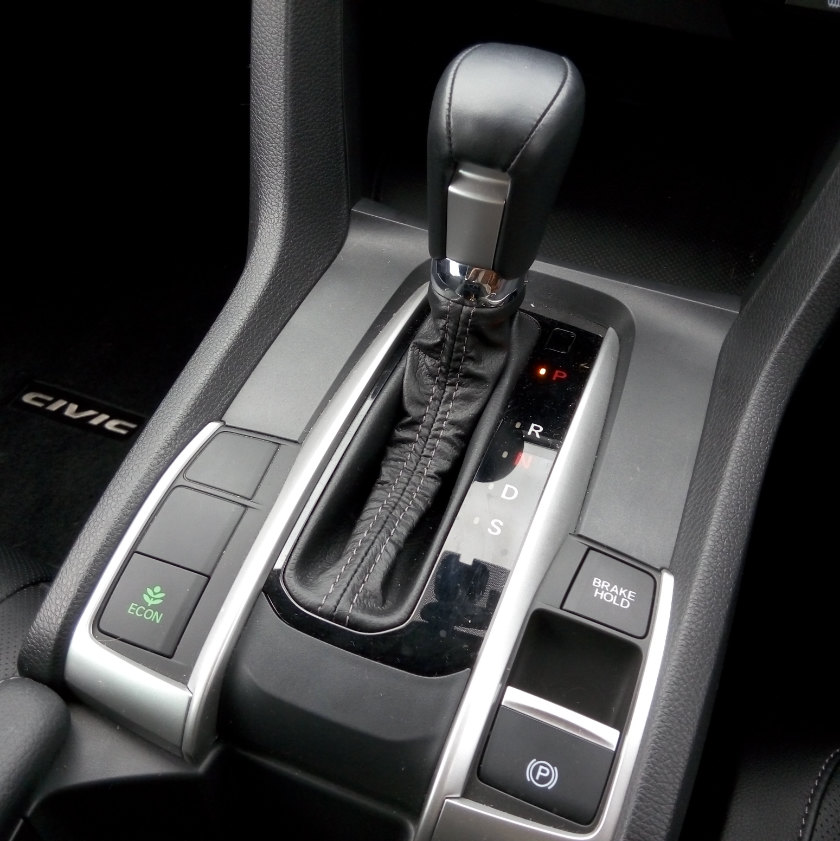 Above, from top: A well screwed together interior—we can believe Audi was a benchmark. You can slide your fingers across the sensor to increase and decrease volume. Fully digital rev counter and speedometer display: one up on many of its rivals in this segment. A very accurate representation of distances when the left indicator is on, aiding safety. Infotainment screen might be garish to western eyes. The automatic shifter’s comfortable.
Above, from top: A well screwed together interior—we can believe Audi was a benchmark. You can slide your fingers across the sensor to increase and decrease volume. Fully digital rev counter and speedometer display: one up on many of its rivals in this segment. A very accurate representation of distances when the left indicator is on, aiding safety. Infotainment screen might be garish to western eyes. The automatic shifter’s comfortable.
We had no issues connecting the car to an Apple Iphone, but our Meizu M2 Note proved a challenge. Being a Chinese-market phone, it had no Google services on it, upon which, we believe, Android Auto relies. Regular, western Android users should find no issues, but being Google-free could come at a rare disadvantage here. That also meant that sat-nav, which is available on the Civic but only through Iphone Connect or Android Auto, wasn’t available on our test.
The screen is where the Japanese æsthetic might not be to everyone’s tastes. The typeface is Japanese designed: while it displays in the English language using the Latin alphabet, it wasn’t particularly easy on the eyes. The colours may be right for a culture whose cities delight in neon lights, but occidental eyes might prefer greater subtlety.
Finally, there is a quirk which detracts from everyday use. The reversing camera comes on when reverse gear is engaged, which makes total sense. However, when you leave reverse, the camera instantly switches off. Rival manufacturers have units where a few more seconds’ grace is granted, and you need that extra time to make sure, for instance, that you have got the rear of the car ahead of the white line in a parking space. You’ll need to make sure, because this Civic is long (74 mm up from the previous model for a 4,644 mm overall length, with an extra 30 mm in the wheelbase). That’s good news for those who want a massive boot for their saloon cars (Honda cites 517 ℓ) and expect to have rear-seat passengers on occasion—but not for getting into tight spots. Those readers who might have owned a fourth-generation Accord (the 1989–93 version, considered long in its day) might be surprised to learn that that sedan was 4,680 mm long; and this Civic’s 1,799 mm width trumps that Accord’s 1,700 mm. Given how practical the door mirror-mounted camera was, this quirk was a real surprise.
We had tested that earlier Accord, too, prior to Lucire’s founding, and noted that it was geared toward comfort. This Civic isn’t an exception, with, of course, the dynamics brought up to date to 2017. It has well weighted steering, which is incredibly communicative through a lush leather steering wheel: Honda’s engineers should be commended here. It might be 4,644 mm long, but you don’t feel it once you’re driving. Tight corners are dealt to without any fuss, and as a daily proposition, the Civic RS Turbo is an excellent family car.
The name, then, is a misnomer. RS Turbo conveys ideas of chavs in Ford Escorts on housing estates; but like the GTI badge on the Volkswagen Golf IV, or the SV6 badge on the VE Holden Commodore, it doesn’t really mean what it says. Honda evidently has identified a buyer who wants comfort and practicality, yet who wants style and the impression of sportiness, but that driver isn’t interested in unleashing their car on twisty B-roads. That spoiler on the back might mean business, and it looks like an evil robot’s eyeshade, but ultimately it’s going to help achieve a better fuel economy rating than create rearward downforce. (On that point, we achieved 7·4 ℓ/100 km, or a very respectable 38·17 mpg, helped in no small part by the Civic’s stop–start.) It’s not the NSX of Ayrton Senna; it’s for a driver who wants something looking special every day. Given how well the Australians have done with S packs for their full-size cars over the years, Honda might be on to something.
The seats are comfortable, and the electric adjustment (curiously, on the driver’s side only; the front passenger has manual controls) gets you into the perfect position. Once again, you’re reminded of the traditional Honda buyer: someone who’s more sensible and grounded, not a hoon. Those ten speakers inside can crank out Skrillex, but we found it was equally at home with National Radio, though the steering wheel-mounted volume control took a bit of getting used to (you can slide your finger up and down, rather than press buttons).
In fact, there’s no Jekyll and Hyde character here: it’s Dr Jekyll all the way, except Dr Jekyll is dressed in sports gear and looking like he’s ready for a triathlon. It’s not aggressive and there isn’t anything to be unleashed. He’s going to do the triathlon at his own pace, thank you very much.
Nevertheless, we did take the Civic on windy roads in Haywards, a great place to test cars in the Wellington region. It was competent, but fuss-free and quiet. Refinement is excellent and it soaked up any bumps with ease. The car was composed and manœuvrable.
But you’re left with the sense that this is Honda’s toe in the water. The chassis can handle much more power, and you just know that the Type R, shown to UK journalists last week, is going to make full use of it, with 310 PS and springs that are 200 per cent stiffer up front. Motorheads can salivate right now because that Civic mixes sophistication with raw power. It has a manual gearbox as standard. However, family buyers wanting an on-trend car with sporty details have an excellent choice in the Civic RS Turbo—and as long as infotainment æsthetics aren’t high on your agenda, we’re recommending this ahead of the Toyota Auris and Corolla, and the Mazda Axela (3 outside Japan). Honda is back with its best assault on the C-segment in years. •
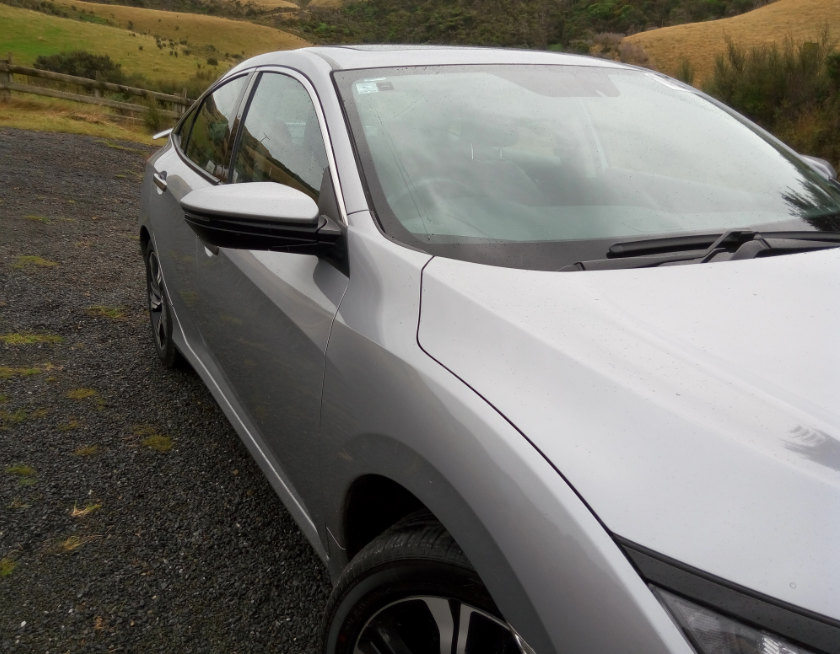

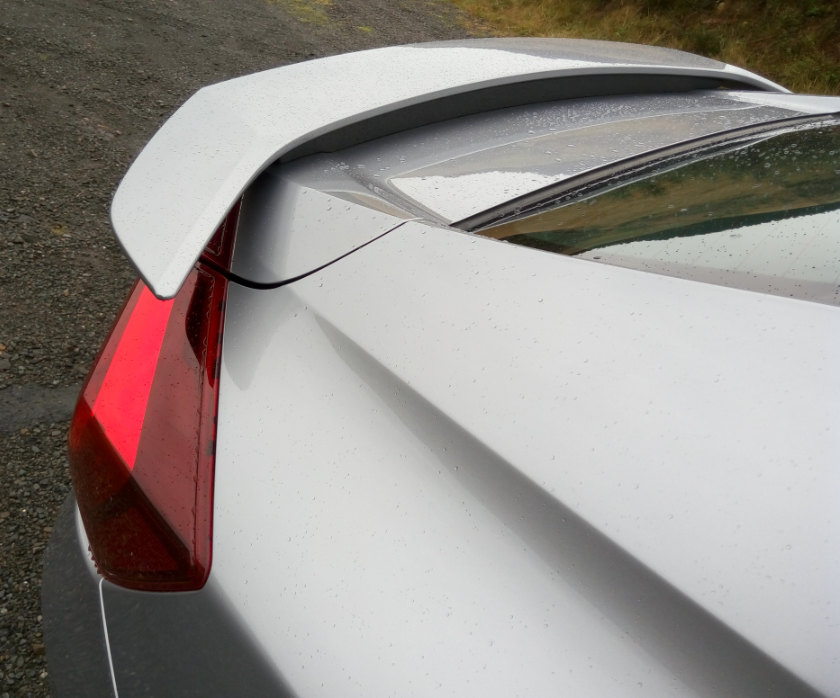
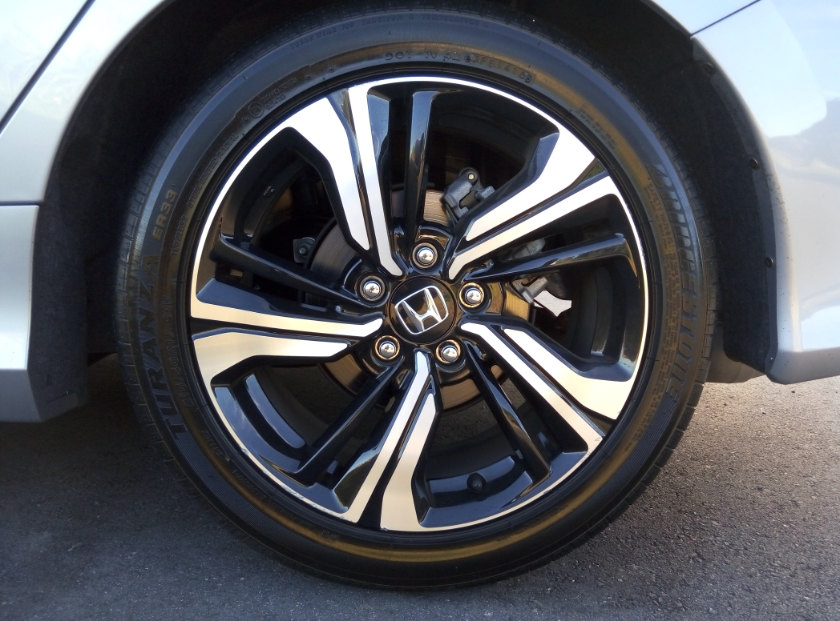 Sporting details Right down to a spoiler that looks like a robot’s eyeshade, and blacked-out detailing that’s de rigueur for sports’ models today
Sporting details Right down to a spoiler that looks like a robot’s eyeshade, and blacked-out detailing that’s de rigueur for sports’ models today
Related articles hand-picked by our editors
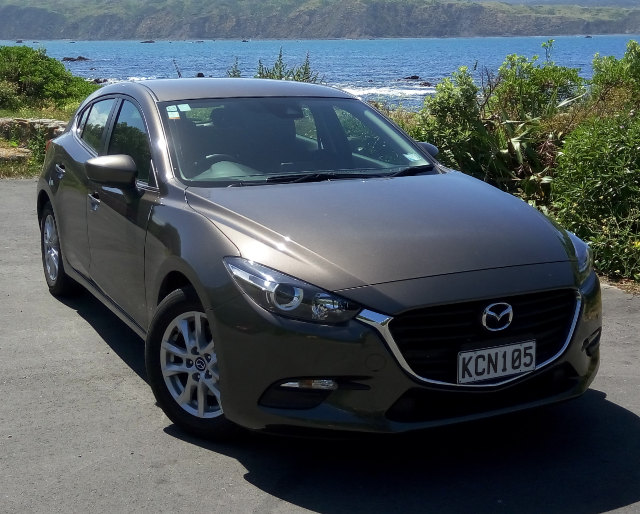
Japanese international
Mazda’s Axela, sold as the 3 in its export markets, is a fine example of what the plucky Japanese firm can do with small volumes and lots of independent thinking, writes Jack Yan
Photographed by the author
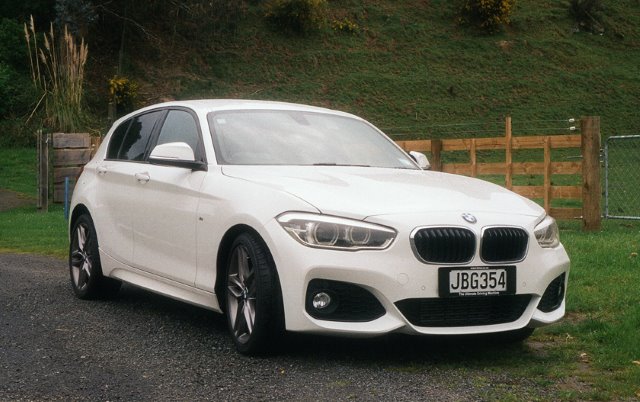
BMW 125i M Sport: flexing its technical muscles
Jack Yan revisits the
BMW 125i with M Sport package, now that it has had a makeover—plus gadgets including BMW’s Connected Drive concierge service and the ability to read the news to you
photographed by the author
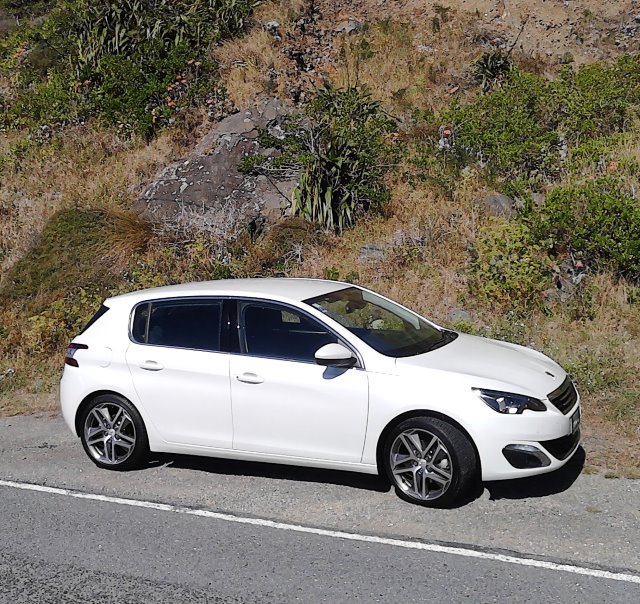
French class
A confessed Francophile when it comes to cars, Jack Yan gets behind the wheel of Peugeot’s award-winning 308, in its flagship Allure 2·0 Blue HDi guise, and discovers a very complete, compelling entry
photographed by the author and by Yvonne Tucker
Advertisement
Copyright ©1997–2022 by JY&A Media, part of Jack Yan & Associates. All rights reserved. JY&A terms and conditions and privacy policy apply to viewing this site. All prices in US dollars except where indicated. Contact us here.